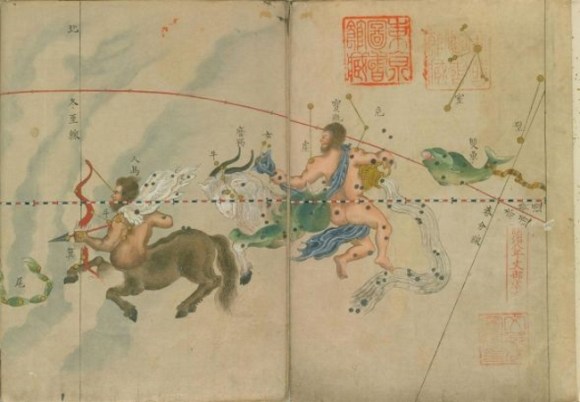
While here at RocketNews24 we pride ourselves on bringing you the latest funky news from around Asia, sometimes we also like to dig into the historical archives where we often find fascinating pieces of trivia. This time, we came across this elaborate, delicate piece of functional art from 18th-century Japan. It’s a detailed star chart that combines astronomy from both the East and West.
Isn’t it fascinating to think that even back in the Edo era there is such a forward-thinking piece which combines different cultures and systems? It looks stunning too!
Attributed to artist Shiba Douryou (Sima Daoliang in Mandarin), father of the famous Edo artist Kitayama Kangan, this star chart was dated to the 7th year under the rule of the Kansei emperor, which would translate to 1795 in the Western calendar. Shiba wrote in an introduction attached to the painting that he had learned that in the West, people identified constellations by making them out to resemble certain symbols – what we know as horoscopes today. Being of Chinese descent, Shiba was familiar with the Chinese Twenty-Eight Mansions, the Eastern method of astronomy in which the night sky was divided into twenty eight constellations of varying sizes. He soon found overlaps between the two astronomical systems and decided to create this ‘conversion chart’ matching horoscopes to the Chinese zodiacal system.
▼ Here Shiba drew the equivalent of the horoscopes Leo, Virgo, Libra and Scorpio.
▼ The red curved line represents the equator. Here we can see representations of Pisces, Aries, Taurus, Gemini and Cancer.
Horoscopes today are more familiar to us as ways to determine if we are romantically compatible with our favorite idols. However, in the past, they used to be spread across the night sky as clusters of shining stars. This beautiful chart is a great manifestation of how different cultures in history had found their own ways to make sense of the world, and how one man in pre-modern Japan had foresight to combine them in one elegant artwork.
Sources: The National Diet Library, h/t Japaaan
Images: The National Diet Library
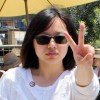

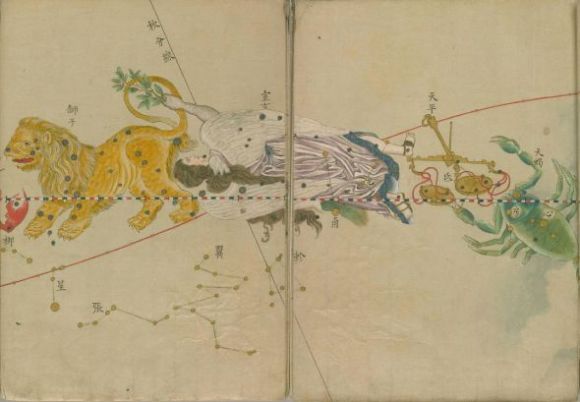
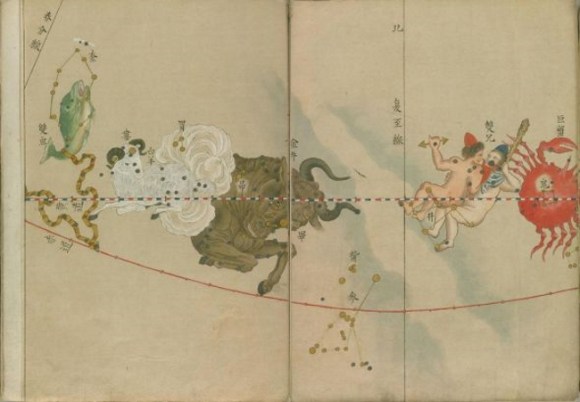
 These 19th-century Japanese miniature landscapes show that size isn’t everything
These 19th-century Japanese miniature landscapes show that size isn’t everything The top 20 places to visit in Tokyo, as chosen by travelers
The top 20 places to visit in Tokyo, as chosen by travelers Have an AI tell your fortune using depth psychology at a new interactive art exhibit in Shibuya
Have an AI tell your fortune using depth psychology at a new interactive art exhibit in Shibuya Artist Mio Hashimoto shares her stunning wooden animal sculptures and methods in new how-to book
Artist Mio Hashimoto shares her stunning wooden animal sculptures and methods in new how-to book Meet your “Bath Time Boyfriend” and let these hot guys pamper you in the bath!
Meet your “Bath Time Boyfriend” and let these hot guys pamper you in the bath! Disney princesses get official manga makeovers for Manga Princess Cafe opening in Tokyo
Disney princesses get official manga makeovers for Manga Princess Cafe opening in Tokyo Randomly running into a great sushi lunch like this is one of the best things about eating in Tokyo
Randomly running into a great sushi lunch like this is one of the best things about eating in Tokyo Is the new Shinkansen Train Desk ticket worth it?
Is the new Shinkansen Train Desk ticket worth it? Foreign English teachers in Japan pick their favorite Japanese-language phrases【Survey】
Foreign English teachers in Japan pick their favorite Japanese-language phrases【Survey】 Beautiful new Final Fantasy T-shirt collection on the way from Uniqlo【Photos】
Beautiful new Final Fantasy T-shirt collection on the way from Uniqlo【Photos】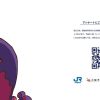 New Japanese mascot character: A train station monster that grabs children who don’t mind the gap
New Japanese mascot character: A train station monster that grabs children who don’t mind the gap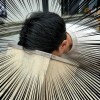 We go looking for the free kaoyu hot spring facebath of onsen town Kusatsu【Photos】
We go looking for the free kaoyu hot spring facebath of onsen town Kusatsu【Photos】 We asked: “What are the hardest and best things about dating a Japanese person?”
We asked: “What are the hardest and best things about dating a Japanese person?” Semi-secret Shinjuku sushi lunch is a great way to get your fish fix for cheap in central Tokyo
Semi-secret Shinjuku sushi lunch is a great way to get your fish fix for cheap in central Tokyo Hey, Japanese taxi driver! Take us to your favorite restaurant in Tsuruga City!
Hey, Japanese taxi driver! Take us to your favorite restaurant in Tsuruga City! We try out “Chan Ramen”, an underground type of ramen popular in the ramen community
We try out “Chan Ramen”, an underground type of ramen popular in the ramen community New Studio Ghibli bedding sets are cool in all senses of the word
New Studio Ghibli bedding sets are cool in all senses of the word Our Japanese reporter visits Costco in the U.S., finds super American and very Japanese things
Our Japanese reporter visits Costco in the U.S., finds super American and very Japanese things New Pokémon cakes let you eat your way through Pikachu and all the Eevee evolutions
New Pokémon cakes let you eat your way through Pikachu and all the Eevee evolutions There’s a park inside Japan where you can also see Japan inside the park
There’s a park inside Japan where you can also see Japan inside the park Japanese convenience store packs a whole bento into an onigiri rice ball
Japanese convenience store packs a whole bento into an onigiri rice ball Hanton rice — a delicious regional food even most Japanese people don’t know about, but more should
Hanton rice — a delicious regional food even most Japanese people don’t know about, but more should Final Fantasy, Kingdom Hearts, and Dragon Quest pet product line announced by Square Enix
Final Fantasy, Kingdom Hearts, and Dragon Quest pet product line announced by Square Enix Studio Ghibli releases Kiki’s Delivery Service chocolate cake pouches in Japan
Studio Ghibli releases Kiki’s Delivery Service chocolate cake pouches in Japan Japan’s bone-breaking and record-breaking roller coaster is permanently shutting down
Japan’s bone-breaking and record-breaking roller coaster is permanently shutting down New definition of “Japanese whiskey” goes into effect to prevent fakes from fooling overseas buyers
New definition of “Japanese whiskey” goes into effect to prevent fakes from fooling overseas buyers Foreign passenger shoves conductor on one of the last full runs for Japan’s Thunderbird train
Foreign passenger shoves conductor on one of the last full runs for Japan’s Thunderbird train Kyoto bans tourists from geisha alleys in Gion, with fines for those who don’t follow rules
Kyoto bans tourists from geisha alleys in Gion, with fines for those who don’t follow rules Studio Ghibli unveils Mother’s Day gift set that captures the love in My Neighbour Totoro
Studio Ghibli unveils Mother’s Day gift set that captures the love in My Neighbour Totoro Domino’s Japan now sells…pizza ears?
Domino’s Japan now sells…pizza ears? Toyota built a life-sized Miraidon Pokémon and are letting people test drive it this weekend
Toyota built a life-sized Miraidon Pokémon and are letting people test drive it this weekend New Japanese KitKat flavour stars Sanrio characters, including Hello Kitty
New Japanese KitKat flavour stars Sanrio characters, including Hello Kitty Sales of Japan’s most convenient train ticket/shopping payment cards suspended indefinitely
Sales of Japan’s most convenient train ticket/shopping payment cards suspended indefinitely Sold-out Studio Ghibli desktop humidifiers are back so Totoro can help you through the dry season
Sold-out Studio Ghibli desktop humidifiers are back so Totoro can help you through the dry season Japanese government to make first change to romanization spelling rules since the 1950s
Japanese government to make first change to romanization spelling rules since the 1950s Ghibli founders Toshio Suzuki and Hayao Miyazaki contribute to Japanese whisky Totoro label design
Ghibli founders Toshio Suzuki and Hayao Miyazaki contribute to Japanese whisky Totoro label design Doraemon found buried at sea as scene from 1993 anime becomes real life【Photos】
Doraemon found buried at sea as scene from 1993 anime becomes real life【Photos】 Tokyo’s most famous Starbucks is closed
Tokyo’s most famous Starbucks is closed One Piece characters’ nationalities revealed, but fans have mixed opinions
One Piece characters’ nationalities revealed, but fans have mixed opinions We asked a Uniqlo employee what four things we should buy and their suggestions didn’t disappoint
We asked a Uniqlo employee what four things we should buy and their suggestions didn’t disappoint Princesses, fruits, and blacksmiths: Study reveals the 30 most unusual family names in Japan
Princesses, fruits, and blacksmiths: Study reveals the 30 most unusual family names in Japan Studio Ghibli’s new desktop Howl’s Moving Castle will take your stationery on an adventure
Studio Ghibli’s new desktop Howl’s Moving Castle will take your stationery on an adventure Shiba Inu watches humans on YouTube, internet has officially come full circle 【Videos】
Shiba Inu watches humans on YouTube, internet has officially come full circle 【Videos】 Adorable, edible dog buttholes are part of this new take on traditional Japanese sweets
Adorable, edible dog buttholes are part of this new take on traditional Japanese sweets Japan’s Kawakami Dogs: Descended from wolves, adorable as puppies 【Video】
Japan’s Kawakami Dogs: Descended from wolves, adorable as puppies 【Video】 Flashing green orb seen shooting across sky in Japan【Video】
Flashing green orb seen shooting across sky in Japan【Video】 Travel through time with these old maps from the Zenrin Virtual Museum
Travel through time with these old maps from the Zenrin Virtual Museum Japan’s curious obsession with blood type and personality illustrated in one photo
Japan’s curious obsession with blood type and personality illustrated in one photo Shiba Inu marshmallows from Japan may be too cute to eat, are definitely too soft to not squeeze
Shiba Inu marshmallows from Japan may be too cute to eat, are definitely too soft to not squeeze Dog’s response to other dog is perfectly acceptable…for a parkour athlete【Video】
Dog’s response to other dog is perfectly acceptable…for a parkour athlete【Video】 There’s something strange with these Hollywood horrors: they’re adorable and awesome! 【Art】
There’s something strange with these Hollywood horrors: they’re adorable and awesome! 【Art】 Chinese rock stars in rocks – depicting music gods as temples devoted to them【Art】
Chinese rock stars in rocks – depicting music gods as temples devoted to them【Art】 Consumer Reports: Do these workout shirts really show too much nipple?
Consumer Reports: Do these workout shirts really show too much nipple? Japan’s 3-D Shiba glasses dress up in kimono for wonderful wafuku tea time【Photos】
Japan’s 3-D Shiba glasses dress up in kimono for wonderful wafuku tea time【Photos】 This Shiba Inu and his kitty best friend are too adorable to ignore!【Photos】
This Shiba Inu and his kitty best friend are too adorable to ignore!【Photos】 Shiba Inu stuck in a bush is so cute you’ll soil yourself!【Photos】
Shiba Inu stuck in a bush is so cute you’ll soil yourself!【Photos】 Forget hamsters, Shiba Inus have the chubbiest, most smooshable cheeks of all! 【Photos】
Forget hamsters, Shiba Inus have the chubbiest, most smooshable cheeks of all! 【Photos】
Leave a Reply